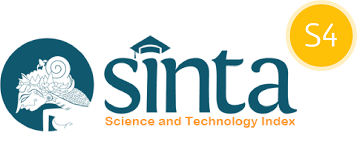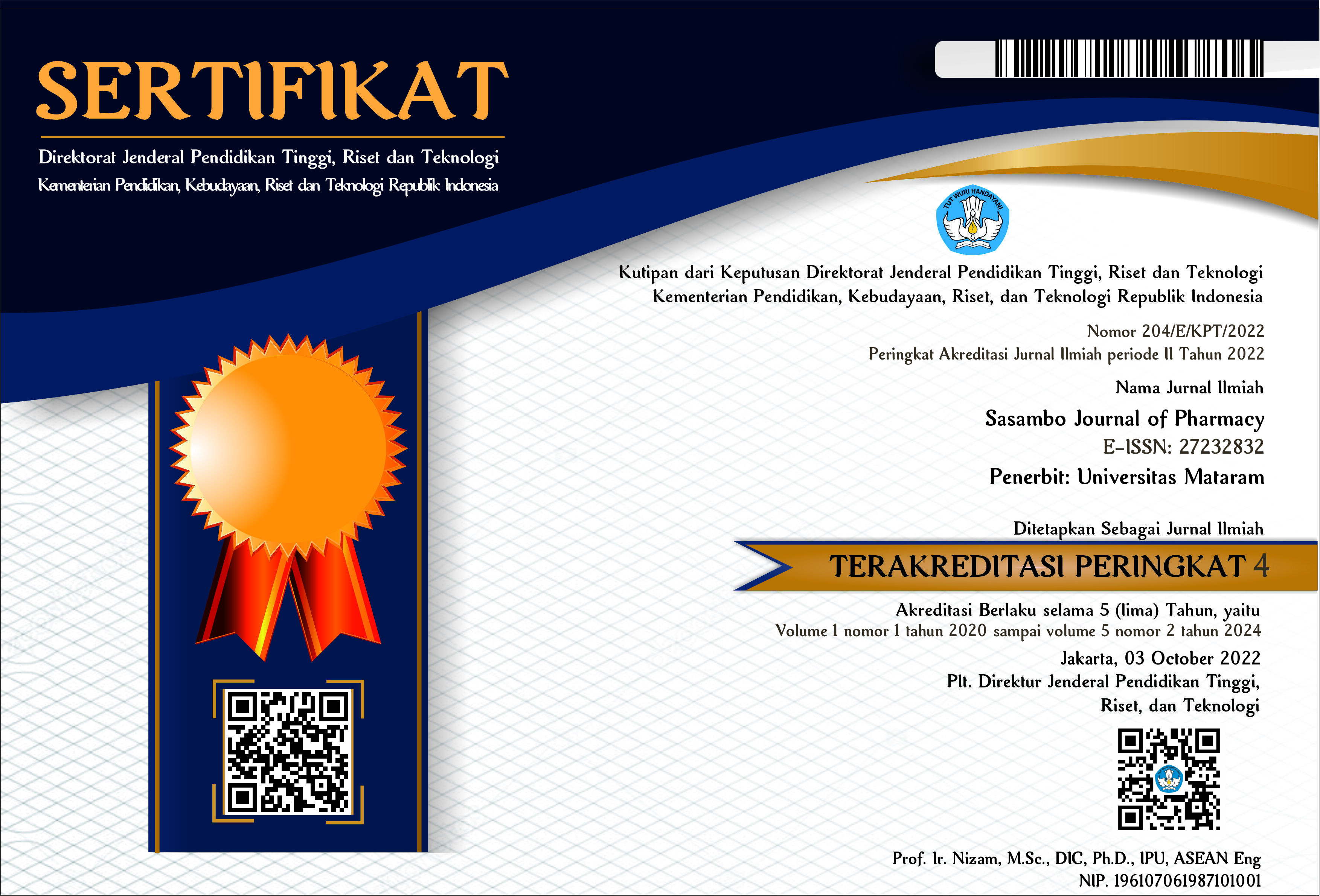Correlation of low body mass index and albumin level with the presence of liver dysfunction in newly diagnosed tuberculosis patients
DOI:
10.29303/sjp.v2i2.105Downloads
Abstract
Tuberculosis (TB) patients often experience reduced appetite or nutritional malabsorption leading to malnutrition, which manifests in excessive loss of muscle mass and low body mass index (BMI). Patients with protein malnutrition is associated with increased risk of drug-induced liver injury and may require a close monitoring during the course of antituberculosis (AT) treatment. The purpose of this study was to determine the correlation of low body mass index and albumin level with liver dysfunction in patients newly diagnosed with TB prior to receiving AT drugs. This study is a nonexperimental observational study with consecutive sampling technique by following a descriptive analytic design (cohort study). The subjects were patients in the National Lung Health Center Makassar who are newly diagnosed with TB and have not received any AT drug. The BMI data and blood samples were collected and analyzed to obtain Alanine aminotransferase (ALT), Aspartat aminotransferase (AST), and Albumin levels. It was found that out of 22 total patients, 3 (14%) of the TB patients experienced liver dysfunction characterized by high level of ALT and AST levels. Both patients had normal levels of albumin despite one of them had a low BMI. The statistical showed no correlation between the low BMI or albumin level with the presence of liver dysfunction. It is concluded that the presence of liver dysfunction is not correlated with low BMI or albumin level in newly diagnosed TB patients, and hence, are not considered as independent risk factors of liver dysfunction in this population.Keywords:
Tuberculosis, BMI, AlbuminReferences
Bharadwaj S, Ginoya S, Tandon P, Gohel TD, Guirguis J, Vallabh H, et al. (2016). Malnutrition: Laboratory markers vs nutritional assessment. Gastroenterology report; 4(4): 272-280.
Bhargava A, Chatterjee M, Jain Y, Chatterjee B, Kataria A, Bhargava M, et al. (2013). Nutritional status of adult patients with pulmonary tuberculosis in rural central india and its association with mortality. PloS one; 8(10).
Borgdorff M, Nagelkerke N, Dye C, and Nunn P. (2000). Gender and tuberculosis: A comparison of prevalence surveys with notification data to explore sex differences in case detection. The International Journal of Tuberculosis and Lung Disease; 4(2): 123-132.
Dotulong J, Sapulete MR, and Kandou GD. (2015). Hubungan faktor risiko umur, jenis kelamin dan kepadatan hunian dengan kejadian penyakit tb paru di desa wori kecamatan wori. Jurnal Kedokteran Komunitas dan Tropik; 3(2): 121-126.
Gounden V, Vashisht R, and Jialal I. (2020). Hypoalbuminemia, StatPearls Publishing: Treasure Island (FL). p. Available from: https://www.ncbi.nlm.nih.gov/books/NBK526080/Gupta KB, Gupta R, Atreja A, Verma M, and Vishvkarma S. (2009). Tuberculosis and nutrition. Lung India : official organ of Indian Chest Society; 26(1): 9-16.
Karyadi E, Schultink W, Nelwan RH, Gross R, Amin Z, Dolmans WM, et al. (2000). Poor micronutrient status of active pulmonary tuberculosis patients in indonesia. The Journal of nutrition; 130(12): 2953-2958.
Keller U. (2019). Nutritional laboratory markers in malnutrition. Journal of clinical medicine; 8(6): 775.
Kemenkes R. Infodatin. (2014). Pusat data dan informasi kementerian kesehatan RI. Jakarta: Kementerian Kesehatan RI; 109(1): 1-8.
Kenedyanti E and Sulistyorini L. (2017) Analisis mycobacterium tuberculosis dan kondisi fisik rumah dengan kejadian tuberkulosis paru. Jurnal Berkala Epidemiologi; 5(2): 152-162.
Khalili H, Dashti-Khavidaki S, Rasoolinejad M, Rezaie L, and Etminani M. (2009). Antituberculosis drugs related hepatotoxicity; incidence, risk factors, pattern of changes in liver enzymes and outcome. DARU; 17(3): 163-167.
Knechel NA. (2009). Tuberculosis: Pathophysiology, clinical features, and diagnosis. Critical Care Nurse; 29(2): 34-43.
Lai H-H, Lai Y-J, and Yen Y-F. (2017). Association of body mass index with timing of death during tuberculosis treatment. PloS one; 12(1).
Makhlouf HA, Helmy A, Fawzy E, El-Attar M, and Rashed HAG. (2008). A prospective study of antituberculous drug-induced hepatotoxicity in an area endemic for liver diseases. Hepatology international; 2(3): 353-360
Sidabutar B, Soedibyo S, and Tumbelaka A. (2004). Nutritional status of under-five pulmonary tuberculosis patients before and after six-month therapy. Paediatrica Indonesiana; 44(1): 21-4.
Yen Y-F, Chuang P-H, Yen M-Y, Lin S-Y, Chuang P, Yuan M-J, et al. (2016). Association of body mass index with tuberculosis mortality: A population-based follow-up study. Medicine; 95(1).
Shu C, Lee C, Lee M, Wang JY, Yu C, and Lee L. (2013). Hepatotoxicity due to first-line antituberculosis drugs: A five-year experience in a taiwan medical centre. The International Journal of Tuberculosis and Lung Disease; 17(7): 934-939.
License
Authors who publish with Sasambo Journal of Pharmacy (SJP), agree to the following terms:
- Authors retain copyright and grant the journal right of first publication with the work simultaneously licensed under a Lisensi Creative Commons Atribusi 4.0 Internasional. This license allows authors to use all articles, data sets, graphics and appendices in data mining applications, search engines, web sites, blogs, and other platforms by providing an appropriate reference. The journal allows the author(s) to hold the copyright without restrictions and will retain publishing rights without restrictions.
- Authors are able to enter into separate, additional contractual arrangements for the non-exclusive distribution of the journal's published version of the work (e.g., post it to an institutional repository or publish it in a book), with an acknowledgment of its initial publication in Sasambo Journal of Pharmacy
- Authors are permitted and encouraged to post their work online (e.g., in institutional repositories or on their website) prior to and during the submission process, as it can lead to productive exchanges, as well as earlier and greater citation of published work (See The Effect of Open Access).







